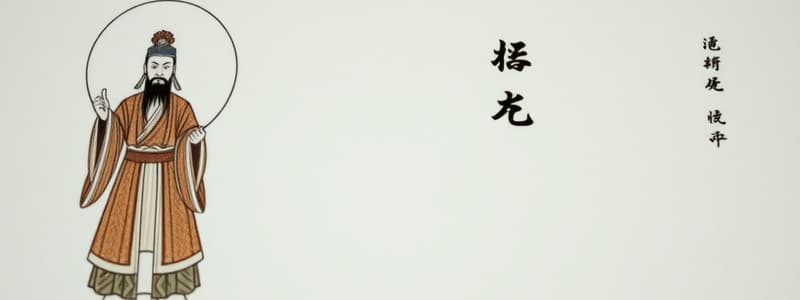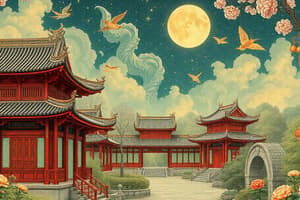Podcast
Questions and Answers
Which of the following best describes the impact of European trade on the Ming dynasty's economy?
Which of the following best describes the impact of European trade on the Ming dynasty's economy?
- It led to the adoption of gold as the primary currency.
- It resulted in silver becoming the dominant form of currency. (correct)
- It fostered economic self-sufficiency, reducing reliance on foreign goods.
- It caused a decline in domestic handicrafts and manufacturing.
How did the promotion of Confucianism impact Ming society and culture?
How did the promotion of Confucianism impact Ming society and culture?
- It diminished the role of literature and drama in society.
- It encouraged the adoption of foreign ideologies.
- It led to a decline in classical learning and the arts.
- It influenced all aspects of society and culture as the state ideology. (correct)
What was the primary purpose of rebuilding and expanding the Great Wall during the Ming dynasty?
What was the primary purpose of rebuilding and expanding the Great Wall during the Ming dynasty?
- To defend against internal rebellions within China
- To serve as a symbol of Ming dynasty's power and prestige
- To protect against Mongol incursions from the north (correct)
- To facilitate trade with neighboring regions
Which of the following internal factors significantly contributed to the decline of the Ming dynasty?
Which of the following internal factors significantly contributed to the decline of the Ming dynasty?
How did silver shortages impact the Ming dynasty?
How did silver shortages impact the Ming dynasty?
What event marked the end of the Ming dynasty in Beijing?
What event marked the end of the Ming dynasty in Beijing?
What strategic decision ultimately facilitated the establishment of the Qing dynasty?
What strategic decision ultimately facilitated the establishment of the Qing dynasty?
What was the Weisuo system implemented by the Ming Dynasty?
What was the Weisuo system implemented by the Ming Dynasty?
Which factor most significantly contributed to Zhu Yuanzhang's successful rise to power and the establishment of the Ming dynasty?
Which factor most significantly contributed to Zhu Yuanzhang's successful rise to power and the establishment of the Ming dynasty?
Which of the following best describes the primary purpose of Zheng He's voyages during the Yongle Emperor's reign?
Which of the following best describes the primary purpose of Zheng He's voyages during the Yongle Emperor's reign?
How did the Hongwu Emperor's land reforms impact the social structure of China?
How did the Hongwu Emperor's land reforms impact the social structure of China?
What was the main function of the Lijia system implemented during the Hongwu Emperor's rule?
What was the main function of the Lijia system implemented during the Hongwu Emperor's rule?
Which of the following factors contributed to the Ming dynasty's decision to halt Zheng He's voyages?
Which of the following factors contributed to the Ming dynasty's decision to halt Zheng He's voyages?
What role did the Grand Secretariat play in the Ming Dynasty's governance?
What role did the Grand Secretariat play in the Ming Dynasty's governance?
How did the Ming dynasty refine the traditional Confucian-based civil service examination system?
How did the Ming dynasty refine the traditional Confucian-based civil service examination system?
Which of the following describes a key agricultural innovation that contributed to increased food production during the Ming dynasty?
Which of the following describes a key agricultural innovation that contributed to increased food production during the Ming dynasty?
Flashcards
Ming Dynasty
Ming Dynasty
Chinese dynasty ruling from 1368 to 1644, following the Yuan dynasty. Founded by Zhu Yuanzhang.
Zhu Yuanzhang (Hongwu Emperor)
Zhu Yuanzhang (Hongwu Emperor)
The founder of the Ming Dynasty; a peasant who rose through the Red Turban Rebellion.
Red Turban Rebellion
Red Turban Rebellion
Religious and political movement with anti-Mongol sentiments during the late Yuan dynasty; Zhu Yuanzhang rose through its ranks.
Lijia System
Lijia System
Signup and view all the flashcards
Yongle Emperor (Zhu Di)
Yongle Emperor (Zhu Di)
Signup and view all the flashcards
Zheng He's Voyages
Zheng He's Voyages
Signup and view all the flashcards
Civil Service Examination System
Civil Service Examination System
Signup and view all the flashcards
Grand Secretariat
Grand Secretariat
Signup and view all the flashcards
What was the Ming Dynasty?
What was the Ming Dynasty?
Signup and view all the flashcards
What handicrafts flourished in the Ming Dynasty?
What handicrafts flourished in the Ming Dynasty?
Signup and view all the flashcards
What was the main currency during the Ming Dynasty?
What was the main currency during the Ming Dynasty?
Signup and view all the flashcards
What was the state ideology of the Ming Dynasty?
What was the state ideology of the Ming Dynasty?
Signup and view all the flashcards
What was the purpose of rebuilding the Great Wall during the Ming Dynasty?
What was the purpose of rebuilding the Great Wall during the Ming Dynasty?
Signup and view all the flashcards
What was the Weisuo system?
What was the Weisuo system?
Signup and view all the flashcards
What internal factors led to the Ming Dynasty's decline?
What internal factors led to the Ming Dynasty's decline?
Signup and view all the flashcards
Who did Wu Sangui ally with, leading to the end of the Ming Dynasty?
Who did Wu Sangui ally with, leading to the end of the Ming Dynasty?
Signup and view all the flashcards
Study Notes
- The Ming dynasty ruled China from 1368 to 1644 after the collapse of the Yuan dynasty
- It was founded by Zhu Yuanzhang, who took the Hongwu Emperor title
- The Ming dynasty was the last imperial dynasty of China ruled by Han Chinese
Rise to Power
- Zhu Yuanzhang, a peasant, rose through the ranks of the Red Turban Rebellion, a religious sect with millenarianist and anti-Mongol sentiments during the late Yuan dynasty
- He capitalized on widespread discontent and famine to gather support
- Zhu captured Nanjing, establishing it as his base and declared himself the Prince of Wu
- In 1368, Zhu Yuanzhang declared himself emperor, marking the start of the Ming dynasty, and initiated military campaigns to expel the Mongols from China
- The Ming army captured Beijing, the Yuan capital, forcing the Mongol court to flee north
Early Ming Emperors
- Hongwu Emperor (Zhu Yuanzhang) initiated land reforms to redistribute land to peasants, weakening the power of wealthy landlords
- He implemented policies to reduce forced labor and promote agriculture
- The Hongwu Emperor implemented the Lijia system, a form of local self-governance based on groups of households, to enhance social control and taxation
- The Yongle Emperor (Zhu Di) seized power from his nephew in a coup
- He moved the capital from Nanjing to Beijing, constructing the Forbidden City
- Yongle Emperor sponsored Zheng He's voyages, involving large-scale naval expeditions to Southeast Asia, India, and East Africa
- These voyages were intended to display Ming power, expand tribute trade, and assert Chinese dominance
- The expeditions were abruptly halted due to budgetary concerns and a shift in priorities towards defense against Mongol threats
Government and Administration
- The Ming dynasty restored and refined the traditional Confucian-based civil service examination system for recruiting officials
- The bureaucracy was highly centralized, and power was concentrated in the hands of the emperor
- The Grand Secretariat was established as an advisory body to the emperor, but its power varied depending on the ruler
- The Ming dynasty saw the emergence of powerful eunuchs who exerted considerable influence over the emperor and the court
- The Ming dynasty used a hierarchical system of administration, dividing the country into provinces, prefectures, and counties
Economy
- Agriculture was the backbone of the Ming economy, with rice being the primary crop
- Technological improvements like improved irrigation techniques and new rice varieties led to increased agricultural output
- The Ming dynasty saw significant growth in handicrafts and manufacturing, especially in textiles, porcelain, and silk
- The dynasty saw the growth of trade, both domestic and international, particularly along the Grand Canal and through maritime routes
- Silver became the primary form of currency during the Ming dynasty, driven by trade with Europeans, who exchanged silver for Chinese goods
Society and Culture
- Confucianism was promoted as the state ideology, influencing all aspects of society and culture
- The Ming dynasty saw a revival of classical learning and the arts
- The dynasty oversaw major literary projects, including the compilation of the Yongle Encyclopedia
- Porcelain production flourished, with Jingdezhen becoming the center of ceramic production
- Popular literature and drama became more widespread, reflecting the changing social and cultural landscape
Military and Defense
- The Ming dynasty maintained a large standing army to defend against internal rebellions and external threats, such as the Mongols and Japanese pirates
- The Great Wall was rebuilt and expanded to protect against Mongol incursions
- The Ming implemented the Weisuo system, a hereditary military system, for maintaining a standing army
- Naval power was significant, especially during Zheng He's voyages, but later declined due to changing priorities
Decline and Fall
- Internal factors contributed to the dynasty's decline, including weak and ineffective emperors, factionalism within the court, and corruption among officials
- Natural disasters, such as droughts and floods, led to widespread famine and peasant uprisings
- Silver shortages, caused by disruptions in trade with the Spanish Empire, created economic instability
- Peasant rebellions, led by figures like Li Zicheng, weakened the dynasty's control over the country
- The Manchus, from the northeast, posed a growing threat, eventually invading and conquering China
- In 1644, Li Zicheng's forces captured Beijing, leading the Chongzhen Emperor to commit suicide
- Ming general Wu Sangui allied with the Manchus to defeat Li Zicheng, opening the way for the establishment of the Qing dynasty
- Remnant Ming forces continued to resist the Qing in the south for several decades, known as the Southern Ming
Studying That Suits You
Use AI to generate personalized quizzes and flashcards to suit your learning preferences.
Description
Explore the Ming Dynasty's rise to power after the Yuan dynasty's collapse. Learn about Zhu Yuanzhang, the Hongwu Emperor, and his land reforms.




